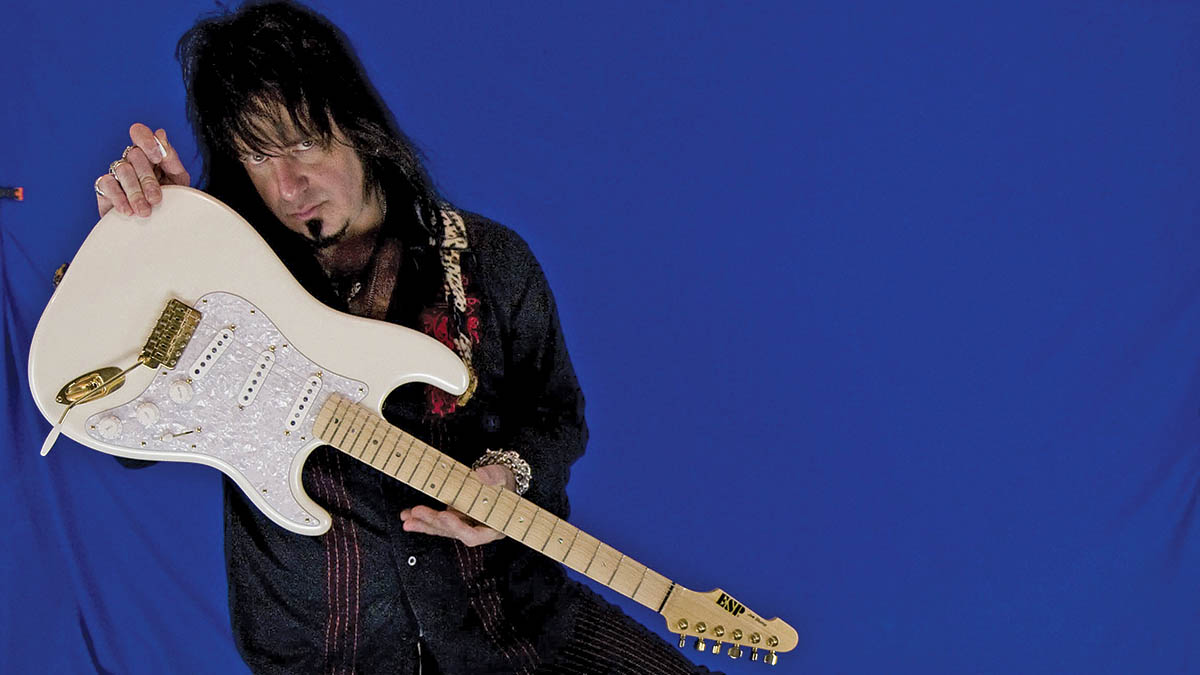Learn the licks of speed metal messiah Joe Stump
A Berklee prof with neoclassical chops to burn, Joe Stump of Alcatrazz is a bona-fide shred legend, and these five examples will whip your metal guitar chops into shape in no time

Joe Stump hails from Queens, New York and spent the ’80s shredding with his band Trash Broadway. In 1993 he became a Berklee instructor specialising in shred guitar.
He has also released a host of solo records, as well as albums under the Joe Stump’s Reign Of Terror moniker, plus recording with ex Malmsteen singer Michael Vescera. And as if that wasn’t enough, Joe is currently the guitarist for Alcatrazz, picking up the gauntlet originally laid down by Yngwie himself, and later Steve Vai.
Joe’s playing is heavily neoclassically influenced, a style he traces back to a love of Ritchie Blackmore, JS Bach and Prokofiev, and he was at the forefront of the neo-classical shred guitar movement throughout the ’80s.
With the following five examples we will explore some of the techniques and approaches that Joe has employed over the decades.
Our first example is an open third-string pedal tone lick based in C harmonic minor (C-D-Eb-F-G-Ab-B). Learning scales laterally along the strings is just as important as learning scale positions. Ultimately, these shapes are a means to an end and you should aim to be always aware of the intervals you are playing in relation to the key.
As well as the more typical harmonic minor sounds, Joe explores more exotic scales too. Example 2 is based in Hungarian minor (1-2-b3-#4-5-b6-7); similar to harmonic minor, but with a #4. This scale works over a minor-major 7th and the #4 adds a mystical Lydian element, an endlessly fascinating sound to explore.
Joe uses a combination of economy, alternate, and sweep picking, all of which we explore in Examples 2-4. The choice of picking technique depends on the number of notes per string being played. For one-note-per-string things, such as arpeggios, sweep picking is the best choice. This involves using a smooth motion to connect the pick with the notes across various strings.
Economy picking is an extension of sweep picking, more useful for three-notes-per-string scales. Ascending a scale would have a repeating pattern of: down-up-down, down-up-down and so on, using a sweep to connect each string change.
The concept is to move the pick the shortest distance possible. For two-notes-per-string however, alternate picking is de rigueur and Joe uses this for combining ‘double picked’ notes with interval jumps and string skips. Each note can be played with a ‘down-up’ regardless of which two strings you are jumping between.
Example 5 is based in E Double Harmonic or Byzantine scale, the 5th mode of the Hungarian minor used in Ex 2. With the intervals 1-b2-3-4-5-b6-7 it’s similar to Phrygian Dominant, but with a Major 7th.
Exploring these exotic but challenging sounds is a fantastic way of injecting new inspiration into your playing.
Get the tone
Amp settings: Gain 9, Bass 6, Middle 6, Treble 8, Reverb 3
Like Malmsteen and Blackmore, Joe uses a scalloped-neck S-style guitar (ESP) into Marshall amps. His sound is heavily distorted with lots of brightness to the tone. He’s constantly switching pickups, too, so which guitar you choose is not overly important. But you’ll need lots of British-style drive (try a Boss DS-2 style distortion pedal), and a dash of reverb.
Example 1
Alternate-pick this C harmonic minor lick using small, controlled down and up-strokes, moving the pick with your thumb joint as well as some loose wrist movement. Avoid digging in too much and make sure you hit the string with the tip of the pick.
Example 2
This riff is based in A Hungarian minor (A-B-C-D#-E-F-G#) scale, starting with palm-muted notes on the bass strings, to separate the notes and add a big punch. Again, use small pick motions and an economy picking style for a smooth overall sound - see if the picking directions shown under the tab work for you.
Example 3
Use alternate picking throughout this lick for tight, metronomic timing. Keep your picking hand at an angle so the upstrokes simultaneously move the pick away from the strings as this will make the downstroke string changes a lot cleaner.
Example 4
This lick uses sweep-picked arpeggios combined with alternate-picked scale patterns on the first string. Keep the lick clean by fretting only one note at a time and using very light palm-muting to aid note separation and general clarity (despite the heavy distortion sound).
Example 5
This heavy metal riff is largely drawn from the E Byzantine scale (E-F-G#-A-B-C-D#), combining double-stops and bursts of speed picking. For economy picking, start with a downstroke on each new string and allow the pick to fall through the scale in a single sweeping motion.
Get The Pick Newsletter
All the latest guitar news, interviews, lessons, reviews, deals and more, direct to your inbox!
Charlie Griffiths plays guitar in acclaimed prog-metal outfit Haken, and has a wealth of experience handling corporate and session gigs for genres as diverse as rock, heavy metal and pop. He has been a regular contributor to Total Guitar, Guitar Techniques, and Guitar World for over a decade, and released his debut solo album Tiktaalika in 2022.








![Joe Bonamassa [left] wears a deep blue suit and polka-dotted shirt and plays his green refin Strat; the late Irish blues legend Rory Gallagher [right] screams and inflicts some punishment on his heavily worn number one Stratocaster.](https://cdn.mos.cms.futurecdn.net/cw28h7UBcTVfTLs7p7eiLe.jpg)


